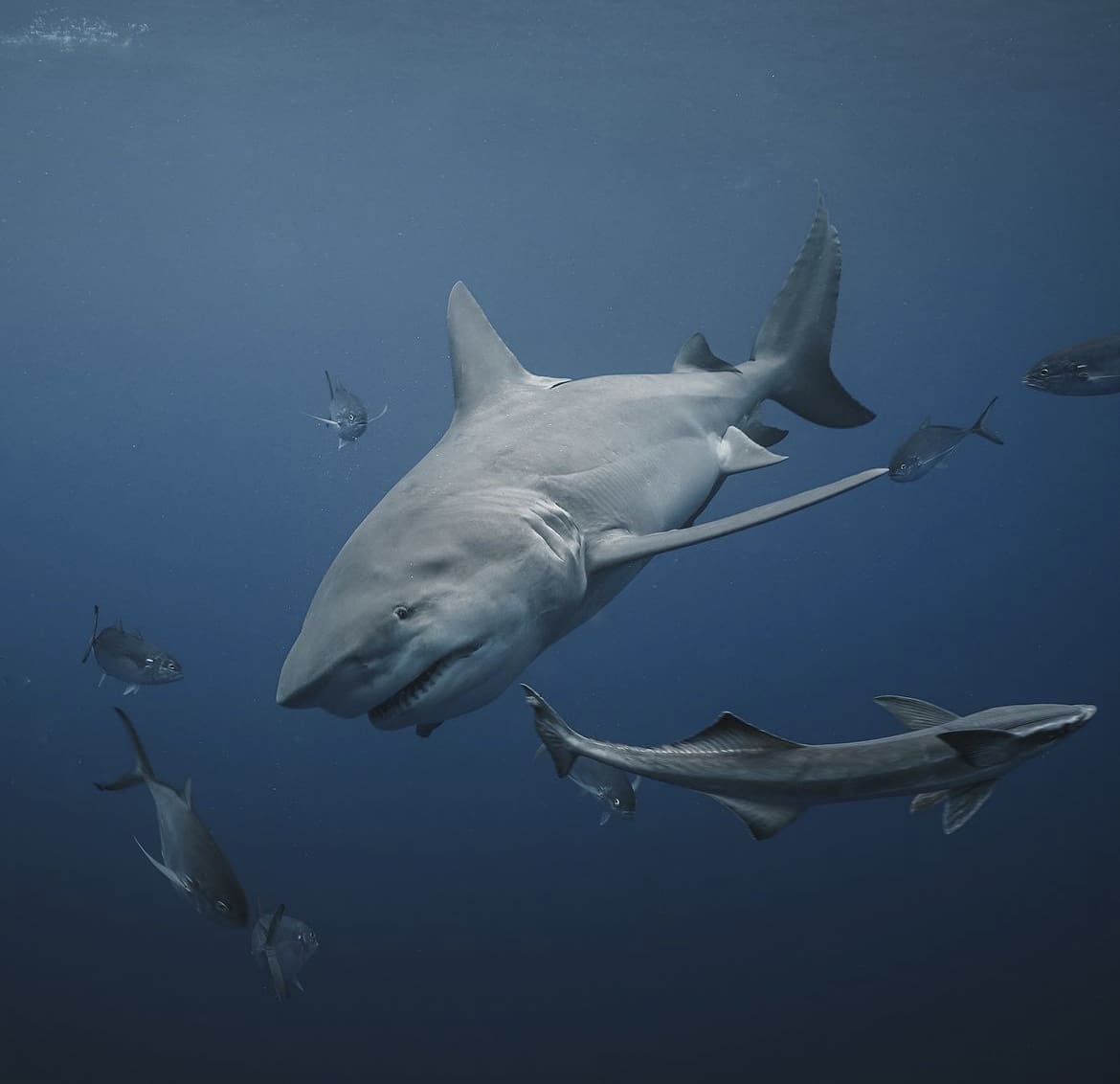Ever find yourself scrolling through your feed, only to be bombarded by yet another sensational shark headline? Well, it’s high time we dive a little deeper and shed some light on one of the ocean’s most misunderstood inhabitants: the bull shark.
These creatures are like the rebels of the sea; breaking rules, crossing boundaries, and honestly, just trying to live their lives without getting a bad rep.
What is the Bull Shark?
So, what’s the deal with bull sharks? They’re not the sharks you see in movies with dramatic music playing in the background. Nope, these guys are more like the wanderers of the shark world. Scientifically known as Carcharhinus leucas, they’re one of the few shark species that don’t mind hanging out in both salt and fresh water. Yeah, you heard that right—freshwater. That’s like finding a penguin in the Sahara. Bull sharks are the tough cookies of the shark family, able to adapt to environments that would send other sharks packing.
Bull sharks are often overshadowed by their more famous cousins, the great whites and hammerheads, but let me tell you, they’re just as fascinating. They play a crucial role in maintaining the balance of marine ecosystems, acting as apex predators that keep other species’ populations in check. Without them, we’d be looking at a very different underwater world.

What Do Bull Sharks Look Like?
Picture this: a sturdy, muscular shark with a broad, flat snout that looks like it’s been squished in a bit too tight. That’s your bull shark. They’ve got this tough-guy appearance that sets them apart from the more streamlined sharks cruising the ocean highways. Their skin is a kind of grayish-brown on top, blending into a softer white underneath, perfect for sneaking up on their prey.
But it’s not just their snout that makes them stand out. Bull sharks have this unique look in their eyes—like they’re always plotting their next move. And their fins? They’re large and in charge, designed to power through both the salty seas and the murky rivers where they sometimes like to hang out.
How Big Are Bull Sharks?
Now, onto the million-dollar question: How big do these bad boys get? On average, bull sharks clock in at about 7 to 11.5 feet long and can tip the scales at 200 to 500 pounds. But don’t let those numbers fool you—some individuals beef up to over 700 pounds. That’s like the heavyweight champion of the shark world!
Despite their size, bull sharks are masters of stealth. They use their bulk to their advantage, muscling through the water with surprising grace. It’s this combination of power and agility that makes them such efficient hunters.

Bull Shark Teeth: Nature’s Perfect Predator
Let’s talk teeth, because, let’s face it, that’s a big part of what makes sharks so fascinating (and a tad bit terrifying, right?). Bull sharks come equipped with a set of chompers that’s nothing short of impressive. Imagine a multi-tool that’s evolved perfectly for the ultimate feast in the ocean. Their teeth are triangular and serrated, like the ultimate steak knife, designed to latch onto anything from fish to sea turtles, and, unfortunately for them, sometimes humans.
But here’s where it gets cool: bull sharks have rows upon rows of these teeth, ready to replace any that get lost during their hearty meals. It’s like having a conveyor belt of teeth, ensuring they’re always ready for their next snack. This dental design isn’t just about being scary; it’s about efficiency. In the murky waters where they often hunt, grabbing and holding onto prey is paramount, and their teeth make them masters of their craft.
Bull Shark Social Structure
If bull sharks had a Facebook status for their social lives, it would be “It’s complicated.” Unlike the social butterflies of the ocean, like dolphins, bull sharks are more the lone wolves. They prefer solitary life or hanging out in small, loose groups when it benefits them, like for hunting or when it’s mating season. There’s no real hierarchy or pack mentality here; it’s more like casual acquaintances in the vast oceanic expanse.
This doesn’t mean they’re antisocial or hermits; they’re just selective about their company. Bull sharks are opportunistic feeders and having too many sharks in one area could mean less food to go around. So, they roam the seas (and rivers), keeping to themselves, unless there’s a good reason to team up.

Are Bull Sharks Aggressive?
Ah, the million-dollar question that’s fueled many a sensational headline. Yes, bull sharks have a reputation for being aggressive, but let’s add some context to that. They’re incredibly adaptable predators with a bit of a territorial streak, which can sometimes lead to encounters with humans. Their natural habitat often overlaps with areas humans like to swim, surf, and play in the water, which can lead to, well, misunderstandings.
But here’s the thing: bull sharks aren’t actively hunting humans. Most shark attacks are cases of mistaken identity. In the murky waters where bull sharks thrive, a human on a surfboard might look suspiciously like a seal or a sea turtle. When they realize their mistake, they usually back off. It’s cold comfort, but it’s not about aggression—it’s about confusion.
In the grand scheme of things, bull sharks, like any wild animal, will defend their territory and go after what they think is prey. They’re not the monsters lurking in the deep, waiting for swimmers, as movies would have you believe. Respect their space, understand their behavior, and the ocean remains a place of wonder, not fear.
Bull Shark Attacks
When it comes to bull sharks and their interactions with humans, the waters are murky with myths and fear, often overshadowing the facts. Yes, bull sharks are responsible for a number of attacks on humans, but context is key. These creatures aren’t patrolling the shallows looking for trouble. Most incidents occur because a bull shark has ventured into human-populated waters in search of food or during their migration and, mistaking a human for their usual prey, act on instinct.
The statistics on shark attacks put things into perspective. Compared to the millions of people swimming in the ocean every day, shark attacks are exceedingly rare. And bull sharks, despite their formidable reputation, are not at the top of the list when it comes to unprovoked attacks on humans. It’s crucial to remember that these encounters are exceptions, not the rule. Education on how to minimize risks, like avoiding swimming at dawn or dusk and staying clear of fishing areas, can dramatically reduce the already low chance of an encounter.

Where Do Bull Sharks Live?
Bull sharks boast one of the most impressive passports in the animal kingdom. They’re found in warm, shallow waters along coasts and in rivers all around the world, from the Mississippi River in the United States to the Amazon River in Brazil, and even the Brisbane River in Australia. Their ability to tolerate both salt and fresh water means they can roam far and wide, often venturing far inland through rivers and estuaries.
Their habitats are as varied as their diet, ranging from the crystal-clear waters of coral reefs and the open ocean to the murky depths of rivers and lakes. This adaptability has allowed bull sharks to colonize a vast array of environments, but it also means they’re more likely to come into contact with humans, leading to their notorious reputation.
Bull Sharks in Freshwater
One of the most fascinating aspects of bull shark biology is their ability to thrive in freshwater environments. Unlike most sharks, which are strictly marine and would perish in freshwater, bull sharks have specialized kidneys and a gland near their tails that help them regulate their internal salt levels, allowing them to venture into and live in rivers and lakes.
This unique adaptation opens up a whole new world for bull sharks, letting them explore territories that other sharks can’t. It’s not uncommon for them to be spotted hundreds of miles upriver, where few would expect a shark to be found. This ability has led to some surprising encounters and has cemented their reputation as one of the most adaptable predators on the planet.
Their presence in freshwater isn’t just a quirk of nature; it’s a testament to the bull shark’s evolutionary success. They can hunt in waters where competition is scarce, and prey is plentiful, giving them an edge that few other sharks have. It’s a remarkable adaptation that showcases the incredible diversity and resilience of shark species.

How Many Bull Sharks Are There in the Ocean?
Pinpointing the exact number of bull sharks in the ocean is like trying to count the grains of sand on a beach—challenging, if not outright impossible. However, researchers and scientists use a combination of tagging, tracking, and observational studies to estimate their populations. These estimates help us understand not just how many bull sharks might be cruising the world’s oceans and rivers, but also how their numbers are holding up against human and environmental pressures.
What we do know is that bull sharks, due to their wide range of habitats and adaptability, have fared better than some other shark species. Yet, like many marine creatures, they’re not immune to the impacts of overfishing, habitat destruction, and climate change. Monitoring their populations is crucial for conservation efforts, ensuring that these apex predators continue to play their vital role in the marine ecosystem.
Are Bull Sharks Endangered?
The conservation status of bull sharks is a bit of a moving target, reflecting the complexities of marine conservation. Currently, the International Union for Conservation of Nature (IUCN) lists the bull shark as “Near Threatened.” This designation points to concerns about their long-term survival due to a combination of factors, including targeted fishing for their fins, bycatch in fisheries, and habitat degradation.
Bull sharks’ propensity to travel into freshwater makes them uniquely vulnerable. In rivers and lakes, they’re more likely to encounter pollution, boat traffic, and fishing activities aimed at other species. Conservation efforts must, therefore, be multifaceted, addressing threats in both marine and freshwater environments to ensure these remarkable sharks can thrive.

Threats to Bull Sharks in the Wild
The life of a bull shark is fraught with dangers, not from natural predators but from the activities of humans. Overfishing is a significant threat, with bull sharks caught intentionally for their meat, fins, and liver oil, and unintentionally as bycatch in fisheries targeting other species. Their fins are particularly valued in some cultures for making shark fin soup, a delicacy that has contributed to the decline of shark populations worldwide.
Habitat destruction poses another critical threat. Coastal development, pollution, and the alteration of river systems can destroy or degrade the nursery grounds essential for young bull sharks’ survival. Climate change and rising sea temperatures also impact their habitat and food sources, with unpredictable consequences for their populations.
Furthermore, the bull shark’s unique ability to swim in freshwater exposes them to additional risks, including barriers like dams that block their migratory paths and pollution from agricultural and urban runoff. These challenges underscore the importance of comprehensive conservation strategies that protect bull sharks across their diverse habitats.
The plight of the bull shark is emblematic of the broader challenges facing sharks and marine life globally. As apex predators, their health reflects the health of the marine ecosystems they inhabit. Protecting bull sharks is not just about saving a single species but about preserving the balance of life in our oceans and rivers.
Where to Dive with Bull Sharks
For the thrill-seekers and marine enthusiasts among us, diving with bull sharks offers an unmatched underwater adventure. But where to find these majestic creatures? Hotspots around the globe are renowned for their clear waters and frequent bull shark sightings. One such place is Playa del Carmen, Mexico, where bull sharks gather in large numbers from November to March. Here, divers can witness these predators in their natural habitat, observing their behaviors up close.
Fiji is another destination not to be missed, offering the famous Shark Reef Marine Reserve where bull sharks, alongside other shark species, are regular visitors. Divers here contribute to shark conservation efforts, as part of the dive fees goes towards marine protection programs.
For those looking to stay closer to the United States, the coast of Florida is a prime location for bull shark encounters, particularly around the Jupiter and Palm Beach areas. These sites offer guided dives that bring you safely into the world of bull sharks, providing a glimpse into their lives beneath the waves.

Tips for Diving with Bull Sharks
Diving with bull sharks can be an exhilarating experience, but it’s not without its risks. Here are some tips to ensure a safe and respectful encounter:
- Choose a reputable dive operator: Look for operators who prioritize safety and ethical interactions with wildlife.
- Stay calm and composed: Quick movements or panic can confuse or startle sharks.
- Maintain a respectful distance: Give sharks their space, allowing them to approach if they choose.
- Avoid feeding: Feeding sharks can alter their natural behaviors and make them associate humans with food.
- Dive in groups: There’s safety in numbers, and sharks are less likely to approach a group.
- Be environmentally conscious: Avoid touching coral or disturbing the marine environment during your dive.
By following these guidelines, divers can enjoy the thrill of swimming with bull sharks while minimizing their impact on these magnificent animals.

Facts about Bull Sharks
- Bull sharks can thrive in both saltwater and freshwater, a unique adaptation among sharks.
- They are known to swim up rivers, with sightings reported as far inland as the Mississippi River in the United States and the Amazon River in South America.
- Bull sharks give birth to live young, with litters ranging from 1 to 13 pups.
- Unlike many shark species, bull sharks do not have a strict migration pattern, instead moving to where food is plentiful.
- They have one of the highest testosterone levels of any animal, which is thought to contribute to their aggressive reputation.
- Bull sharks are opportunistic feeders, with a diet that includes fish, dolphins, and even other sharks.
Myths about Bull Sharks
- Myth: Bull sharks are the most dangerous sharks to humans.
- Fact: While they are responsible for a number of attacks, many are due to mistaken identity in murky waters.
- Myth: Bull sharks deliberately hunt humans.
- Fact: Humans are not natural prey for bull sharks; most encounters are accidental.
- Myth: Bull sharks are only found in the ocean.
- Fact: They are capable of living in both salt and freshwater and have been found far inland in rivers and lakes.
- Myth: Bull sharks are solitary creatures.
- Fact: They can often be found in groups, especially in areas with abundant food sources.
Diving into the world of bull sharks reveals a creature far more complex and fascinating than the fearsome predator often portrayed in media and folklore. Understanding these sharks brings a new level of appreciation for their role in the marine ecosystem and highlights the importance of conserving their populations for future generations.
